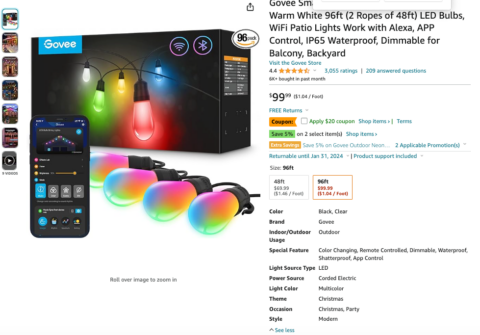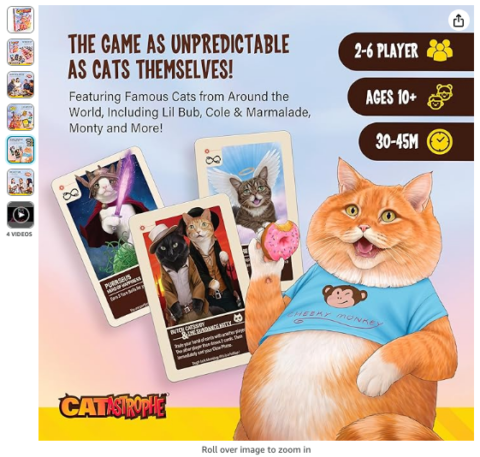Amazon’s algorithm operates differently than most other search engines, which means you need a distinct strategy when attempting to rank on the platform versus platforms like Google and Bing.
To oversimplify, Amazon’s search engine is highly capitalistic; you need sales to get your products to rank organically.
Keyword-rich content is no longer enough to rank; you must have a strategy that includes great copy and images, advertising, and proactive account monitoring to ensure your products can rank and maintain that ranking over time.
Let’s jump into some key points on how to rank your Amazon products.
Understanding Amazon’s Algorithm
Unlike Google, Amazon advertising does impact organic search within the platform.
The Amazon algorithm determines how a product has converted for a specific keyword phrase in the past to know what to put at the top of the organic rankings.
There are, of course, other ranking factors – however, this is the most impactful.
This creates a chicken and an egg problem. To get sales on Amazon through organic ranking, you first have to cause sales for that keyword phrase.
Then, to stay at the top of the organic rankings, you need to continue to outsell your competitor for that keyword.
Any dip due to changes in advertising, pricing suspension, account suspension, or conversion rate issues will cause you to lose your placement at the top of organic search.
This means you need more than just a listing that will convert and is indexed for relevant keywords.
Ranking and launch strategies on Amazon will require that you jumpstart your listings with advertising and potentially a deal or discount to get the organic ranking needed to sell.
It also means proactively avoiding anything that will cause a temporary pause in sales for your products.
Indexing For Relevant Keywords
The most fundamental piece for ranking is ensuring your product is indexed for the most relevant keywords. When looking at keywords, we want to prioritize keywords and phrases that will bring in the most qualified buyers.
When crafting your listing, the most important keywords should be in the title.
Your title will be the primary copy that customers will see on the search engine result page (SERP) and will also be the primary copy for your ads on several of Amazon’s most popular ad types.
For established brands, your most important keywords will be your brand and product name. Then, you should include relevant keyword phrases for your product.
Copy Essentials For Amazon
When writing for Amazon, you are balancing two goals: writing persuasive copy that reads easily and converts to sales, and that maximizes keywords you’re indexing for.
This means before you write your title and bullets, ensure you’ve done complete keyword research and include the most relevant root keywords in your bullet points.
- Root Keywords: The individual words that make up the keywords phrases you want to index and rank for. This is what we focus on in the organic stage of optimization for Amazon.
- Keyword Phrase: This is the keyword phrase in specific orders or sequences you want to focus on ranking for after the listing is indexed for the individual root keywords.
First, look at root keywords relevant to your products and incorporate them into your listing.
Make sure that you are utilizing the structured data for your listings are filled out completely.
Amazon has been surfacing a lot of different kinds of structured data like product weights, compatibility, and materials.
Making sure this is filled out completely and correctly will help with indexing and conversion rate optimization.
-
 Screenshot from Amazon, December 2023
Screenshot from Amazon, December 2023
Amazon has been playing with displaying different structured data in the SERPs and Product Detail pages.
Take the time to fill out all of the available data in the structured data to index your product correctly.
Once your product is live, it’s vital you check that the structured data surfacing on the primary detail page is correct, simple for the customer to identify, and matches your product’s features (dimensions, material, unit count, etc.).
Then compare this to your competitors to make sure it is easy for the right customers to identify whether your product is a good fit for them.
Authority On Amazon
Each product detail page on Amazon is ranked individually. Unlike Google, you’re not able to build authority for a specific brand, and it’s okay to have duplicate content across multiple of your listings.
While it might seem like some brands have built-in authority, it’s only because several people are already searching for them.
As soon as their listings go live, they immediately get sales and conversions, which helps Amazon understand their product better and, in turn, helps their ad relevancy and organic ranking.
Brands with an existing audience and search volume on Amazon will generally have faster, more successful launches.
Why DTC Brands Struggle On Amazon
Unlike direct-to-consumer sales, on Amazon, your competitors will be right next to you on the SERP and on your product detail page, advertising right below your product information.
This means being very clear on your unique selling proposition if you are more expensive than your competitors.
If your product is expensive, it’s crucial to communicate this in your listing copy and primary images, highlighting your product’s unique selling point in a way that customers understand.
It’s also vital that your images mimic the information in your bullets. On mobile, the bullets are further down on the page.
Amazon has also hidden the bullets in some categories under an “About the Product” section that needs to be clicked to be expanded.
-
 Screenshot from Amazon, December 2023
Screenshot from Amazon, December 2023
On Amazon, you need to make sure you add infographic images that display the most important information about your product.
Any information critical to the purchase should be included in the images and/or A+ content.
Ensure your images are the correct size and aspect ratio, as Amazon’s interface may compress images, making your product look smaller or harder to identify.
Once your listings are online, be sure to verify how the thumbnails are loading and how they look next to your competition. This is especially important as the primary image is also used for advertising for most of Amazon’s ad types.
For secondary images, make sure that you include infographics so that the primary details for your products are easily found.
Amazon allows you to add videos to the product detail pages, which can help with conversation, so you want to include these as much as possible.
Reviews Still Play A Role On Amazon
Reviews used to be the way to manipulate Amazon’s search algorithm. Amazon has worked to close that loophole, and they take review manipulation very seriously.
However, reviews still play a role in marketing on Amazon. Reviews help with proof of concept and will help with click-through rate (CTR) and conversion rates.
Programs like “Amazon Vine” or the “Request Review Button” give you information to maximize the total number of reviews for your product.
The text that’s included in reviews can also be indexed for search on Amazon.
This means that if you have a large number of reviews, you might be able to rewrite your list copy to focus more on conversion and not worry as much about maximizing the total number of root keywords you want to be indexed for.
Take Advantage Of The Honeymoon Phase
When launching your product on Amazon, you’re given a short period of time to audition for search terms for that specific product. To maximize this short window, make use of the following:
- Future launch date – Create your product with a future launch date so it doesn’t go live until you are fully ready to launch.
- Utilize FBA – unless at least 90% of your competitors are not using FBA, you will likely need to use FBA to be able to get enough conversions to rank profitably.
- Fully available inventory – Inventory being transferred or not fully checked in will hurt your conversion rate and ad performance.
- Launch with a deal or discount – we usually recommend coupons on launch as sales will not show the strike-through at launch.
- Advertising – Start advertising as soon as your product goes live. Each conversion helps Amazon better understand your product. Launching with ads speeds up this process.
Advertising And Ranking Go Hand In Hand
Today, it is difficult to rank for competitive search terms on Amazon without some paid advertising.
One of the biggest factors for ranking on Amazon is how that product has converted for a specific keyword phrase in the past.
This means that when you are developing an ad strategy you need to not only be looking at what will cause incremental sales, but how your ads will impact your organic ranking.
Two of the biggest mistakes sellers make when running ads on Amazon are advertising too many stock-keeping units (SKUs) or reaching for too many broad targets.
This spreads their budget too thin and doesn’t allow for the advertising to make a significant impact on sales rank.
Focus budgets on a smaller number of targets or SKUs to make sure that you get enough conversions per keyword term. The goal is to rank in the top three positions for the most important keywords and expand that out over time.
It is also sometimes necessary to exclude a relevant but overly broad term in your advertising strategy.
Let’s assume you have a locking beach bag.
“Bag” is a relevant keyword; however, it’s broad. Not only will it be expensive to run ads on that keyword, but even if you did rank organically for the word “bag,” it’s likely you won’t convert well for that word because it’s not specific enough to bring in the buyers you want.
“Locking beach bag” or “beach bag with lock” will have less search volume but will bring in a customer more likely to convert.
In quick terms, here’s a general winning strategy for advertising:
- Only fight battles that you can win.
- Limit the number of SKUs.
- Start with lower-competition keywords.
- Move to more competitive keywords.
- Exclude relevant but overly broad keyword phrases.
Once you’ve established the ranking of your product for the most important keywords, you can look to more ROI-focused campaigns that utilize different search types.
Use video ads with Sponsored Brands and Sponsored Display whenever possible, as these video ads tend to convert well and take up a lot of space in the SERP.
Integrate Your Advertising Results
Once you have your listing completed and your ads running, it’s time to start looking at how you can increase the visibility of our products.
This includes A/B testing your primary image, title, and bullets to maximize click-through rate and conversions.
Utilize the data that you’ve gotten from your advertising and integrate that back into listing changes to test if a change in title can help increase click-through rate and conversions.
Deals And Discounts
Sales and deals can play a large role in ranking products.
Especially during tentpole events like Black Friday or Prime Days, deals or discounts can increase your conversion rate and the total number of conversions for specific keywords, which is key for improving your organic ranking.
There are many different coupons, deals, and sales types on Amazon, and there is no right or wrong approach.
Right now, we’re seeing the best results with coupons at launch and Prime exclusive deals for tentpole days, and for products with existing sales history.
Sale pricing can also be an effective tool, but make sure that you’re monitoring the average selling price over the last 30 days; this determines if that sale displays with a slash through price.
Monitoring how discounts and deals display, what badging is included, and the impact on the average selling price of your item over the last 30 days is important, as Amazon does change these quite often.
Account Health Impacts Organic Ranking
Account health can derail your ranking progress overnight.
If you run out of stock and your competitors are getting sales when you’re not, you will fall down the organic rankings for your most important keywords, and your competitors will take your place.
The same is true with managing inventory; you must proactively prepare for stock-outs. If a product is at risk of stocking out, cut deals and lower ad spend to extend coverage and avoid a stock out.
Here are some other account health and maintenance issues to watch out for:
- In addition to watching for stockouts, manage your FBA storage wisely. Amazon may impose a FBA capacity limit if you don’t.
- Avoid ASIN and product restrictions by checking your account health multiple times each week to monitor your order defect rate, shipping performance, and the voice of the customer.
- Monitor the voice of the customer at least twice a week. Take action if you see more than three similar complaints on the same SKU within 30 days.
- Check your management compliance dashboard, especially during peak times, for new compliance document requirements. Identify and act on compliance issues quickly to avoid ASIN restrictions.
-
 Screenshot from Amazon Seller Central, December 2023
Screenshot from Amazon Seller Central, December 2023
-
You should be checking Voice of the Customer one to three times a week on Amazon Seller Central. Under Performance, Voice of the Customer.
Price Suppression
If Amazon determines that your price is higher than the 30-day trailing price or sees a lower price off Amazon, it might suppress the featured offer (Buy Box).
This suppression causes conversion rates to fall significantly.
Not only does this impact your ranking, but more importantly, it can affect your ability to run ads since sponsored product ads will not run if you do not own the Buy Box.
Ranking Takes Time
The overall ranking on Amazon isn’t an on/off switch; it takes time, and you must work on trying to index for keywords over a more significant period.
It’s normal that for the first 30 to 90 days, ads won’t be profitable as you focus on optimization.
The larger your ad budget, the more quickly you can work to try to rank for those keyword phrases. With larger budgets, it is important to look at ad performance as a group or SKU basis to maintain profitability.
If you’re working with a smaller budget, it’s essential to set expectations, focus on growth over the long term, and make sure you give enough time for your product to start to make progress!
More resources:
- Building An Integrated Search Strategy
- Amazon SEO: A Comprehensive Guide For Sellers
- Ecommerce Marketing: The Definitive Guide
Featured Image: claudenakagawa/Shutterstock





![How To Host Or Migrate A Website In 2025: Factors That May Break Rankings [+ Checklist]](https://www.searchenginejournal.com/wp-content/uploads/2025/05/sidebar1x-652.png)